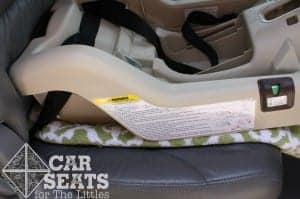Caregivers often ask us how they can protect their vehicle’s seats when a car seat is installed. It’s a valid question, especially coming from expectant parents who wonder what the car seat will do to a previously untouched vehicle interior, one that had been devoid of ground goldfish crackers and spilled beverages until that moment.
The short answer: at CSFTL, we don’t recommend using any product or item between the vehicle seat and the child restraint because as CPSTs, we often see them misused. Ultimately the decision is up to the caregiver but as always, we have some best practice suggestions for you.
The longer answer: Some specific car seats permit the use of specific seat protectors. While we don’t recommend using one, we have compiled a chart of manufacturers’ stances on the use of protectors.
Protect your Vehicle Seats
First and foremost, your car seat or booster seat’s manual has the final word on whether or not a seat protector is permitted underneath your child’s car seat.
The manufacturer may allow a towel, blanket, or their specific brand of seat protector underneath the seat. The manual may specify that nothing should be used under the car seat at all.
Why Seat Protectors can be Dangerous
A thick seat protector or mat between a child restraint (or booster) and vehicle seat introduces space between the two. If the seat protector shifts over time, that can loosen the car seat’s installation.
To help you decide if a seat protector is for you, we’ve done a little field testing on some of the more popular options.
- Thick fabric can compress in the force of a crash, mimicking a loose installation when that bulky fabric compresses under the weight of the seat and force of the collision.
- Seat protectors withgrippy sides can grip the vehicle seat and make the child restraint seem tightly installed, but in reality it may not be.
- In the past, shelf liner was used to help with car seat installation but it’s no longer included in the CPST curriculum because it, too can mask a loose install. Shelf liner can also permanently damage your vehicle’s seats and has been known to melt onto them.
The CPST curriculum refers to good/better/best when talking about all kinds of child passenger safety scenarios. We’ll use that construct here to show how each of these mats do in terms of keeping the seat that they’re under installed correctly.
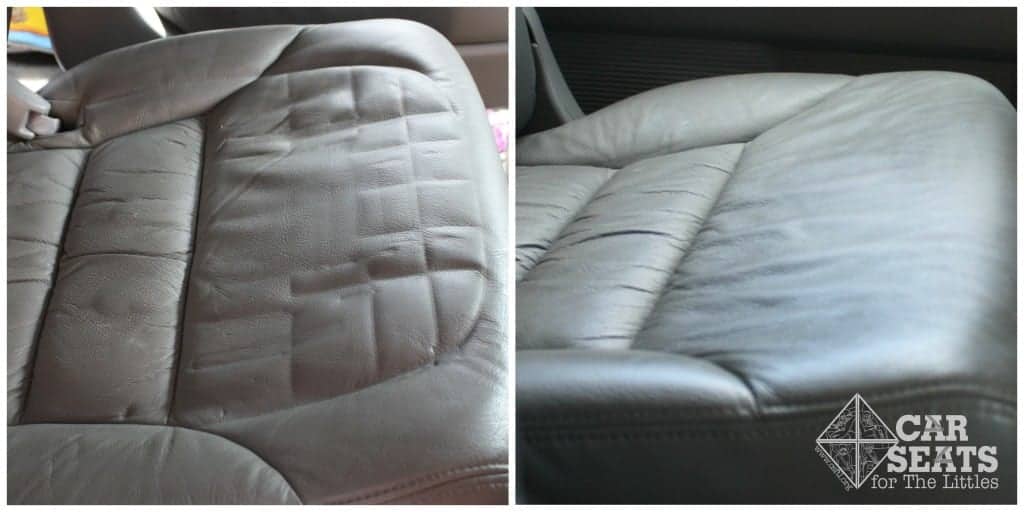
Temporary dents in a vehicle seat
Generally speaking, a properly installed child restraint won’t damage your vehicle’s seats. The dents caused by car seats go away; usually rather quickly — a seat protector isn’t going to prevent that anyway. The best way to care for your leather seats and to keep the vehicle’s interior in good condition is to use proper cleaning products.
With rowdy children in our vehicles, it’s not unusual to see a lot of messes and kid grime. It’s a good idea to keep our vehicles looking their best, or at least not complete grubby. Leather cleaning wipes can help keep those leather vehicle seats clean, but caregivers often wonder about the value of adding a seat protector to keep those surfaces tidy. Here’s the scoop:
Crash Tested?
Some manufacturers test their seat protectors and assert that they comply with Federal Motor Vehicle Safety Standards (FMVSS). This sounds convincing, but here’s the caveat:
There isn’t any mention of seat protectors in the FMVSS standard. There are no standards, regulations, or benchmarks for testing these products.
We don’t know how the seat protectorwas tested and how it performed, or what any of the testing really means for this type of product.
If a company says they’ve tested a seat protector and approves it for use with their car seats, we can trust that they’ve done their own testing and that it is safe to use with their products.
Testing a Seat Protector
Here’s how to see if a specific seat protector works under your child’s car seat:
- Make sure your seat protector is permitted by the car seat manufacturer.
- Follow the instructions in the car seat manual to install the child restraint over the seat protector. Verify that the car seat moves no more than 1 inch at the belt path side to side and front to back.
- Remove the seat protector. There are a few ways to do this:
- Slide the seat protector out from underneath the installed car seat
- Release the vehicle seat belt without loosening the vehicle seat belt
- Release one side of lower anchor connectors without loosening the lower anchor (LATCH) strap.
- Re-buckle the belt or attach the lower anchor strap.
- Test for movement. Does your child’s car seat or base now move more than 1 inch at the belt path? We find that in almost every instance, the car seat now moves more than an inch.
If the car seat tightness has to be adjusted when the seat protector is removed, it is too thick to use.
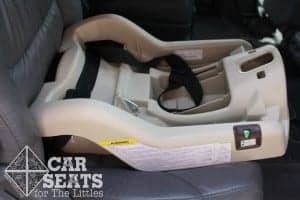
Installed without a seat protector
This test used a Graco SnugRide 30 infant car seat base. Graco allows the use of mats, towels, and blankets under their seats.
When installing a car seat base, check at the belt path to make sure that it isn’t moving more than 1 inch side to side or front to back.
This base is installed using the lower anchors with nothing underneath it. In a world of good/better/best, we’d consider this setup the “best” case scenario.
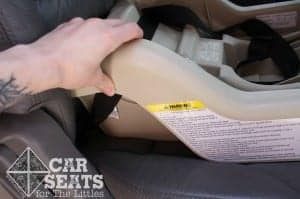
Checking for movement
Check for movement here, at the belt path. All car seats will move at the back and top. As long as it isn’t moving more than 1 inch at the belt path, side to side, or front to back, the install is secure.
In this case, our base remains installed securely since nothing is under it.
Safer Options
Receiving Blanket
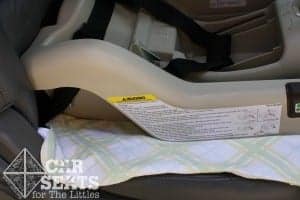
Thin receiving blanket underneath a car seat base
Here, we have a thin receiving blanket under the base. The blanket is so thin that it is not adding any bulk under the base and it doesn’t interfere with the installation in any way.
The blanket slides out if we want to test the installation. With this blanket in place underneath the base, the base didn’t move more than 1 inch at the belt path.
In a world of good/better/best, this is somewhere between “better” and “best”.
Towel

Thin towel underneath a car seat base
Our thin towel works much like the receiving blanket above. We’re able to remove the towel without uninstalling the base. However, the base does move a little more than when the towel was under it, but it does not move more than 1 inch at the belt path.
In a world of good/better/best, this is the “better” scenario.
Less Secure Options
Folded Towel
Here’s a towel that has been folded multiple times. This absolutely replicates situations we’ve seen in the real world. Our towel is very bulky and squishy. We had to release one of the lower anchor connectors in order to remove this towel. The base moves much more than 1 inch at the belt path.
In a world of good/better/best, this doesn’t even meet the criteria for the “good” scenario.
This bulky, folded towelisn’t a safe option because it could compress during a crash.
Seat Protector
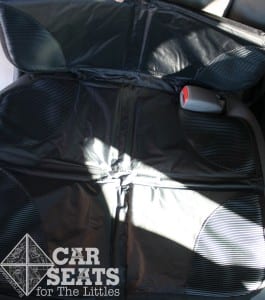
Seat protector
Here we see a seat protector in action. It’s under the base. This protector has two modes — one for infants and one for toddlers. We’ll use the “infant” mode here.
 The tag on this seat protector knows the same things we do — it even has a warning about a secure installation!
The tag on this seat protector knows the same things we do — it even has a warning about a secure installation!

This seat protector restricts access to the lower anchors
The top part of the seat protector is folded, then placed between the base and the vehicle seat per the seat protector’s instructions.
The base can’t be directly next to the seat back because of this folded area. The seat protector claims that it allows access to the lower anchors.
However, this protector covers the lower anchors. Not only does that make it much more difficult to get them attached, that lack of access made installing the base pretty challenging. To go one step further, we were unable to complete our little test because the mat was too thick for us to remove it without uninstalling the seat.
The difficulty in installing and uninstalling the base with this particular seat protector is a clear example of “interfering with the installation.” The warning on the seat protector’s tag says not to use it if it interferes with the installation. Since it interfered, this seat protector isn’t a safe option.
In a world of good/better/best, this doesn’t even meet the criteria for the “good” scenario.
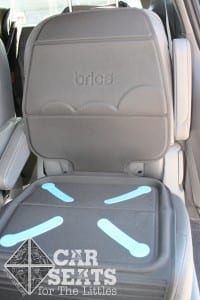
Rigid, thick seat protector — not approved for a safe car seat installation.
The instructions for this very hard, yet oddly popular mat said to use the full mat and clip a strap at the top if the vehicle seat has a headrest.
According to the manufacturer, the hard shell design is meant to prevent vehicle seat compression. It has blue rubber gripper pads on both sides of the lower portion. There’s a note on the instruction guide and on the box about making sure to install your restraint as per the child restraint instructions and my base allows the use of something under it.

Rigid, thick seat protector — not approved for a safe installation.
The lower anchors were easy to access, nothing was covering or obscuring them, so we installed our base using the lower anchors again. We were able to tighten the lower anchors so that the base moved less than an inch side to side, but the rigid mat made this installation rather difficult.
This mat features non-slip pads that seemed to hold the base in place. We would rather see a base or a car seat held in place by the lower anchors or a vehicle seat belt — not a mat!
Testing this Giant Mat
Removing one the of the lower anchors to get the mat out was difficult, but doable.
Once the base was removed, we found that the base could move several inches at the belt path. At that point, the base was not properly installed at all.
In a world of good/better/best, this doesn’t even meet the criteria for the “good” scenario.
Overall Thoughts
Your results with a seat protector mat may be very different from ours, but many aren’t. If you have a seat protector that is approved for use with your specific child restraint and have tested it and found that it does not interfere with installation, you can certainly decide to continue using that item. Hopefully, now you have a better idea of the items you can use and how to make sure that what you’re using is safe.
Always follow the instructions for both your child restraint and seat protector mat, and make sure to read the manual(s) thoroughly. When in doubt, contact the manufacturer or a CPST with questions or concerns.
Originally written by Laurel, edits maintained by CSFTL.

